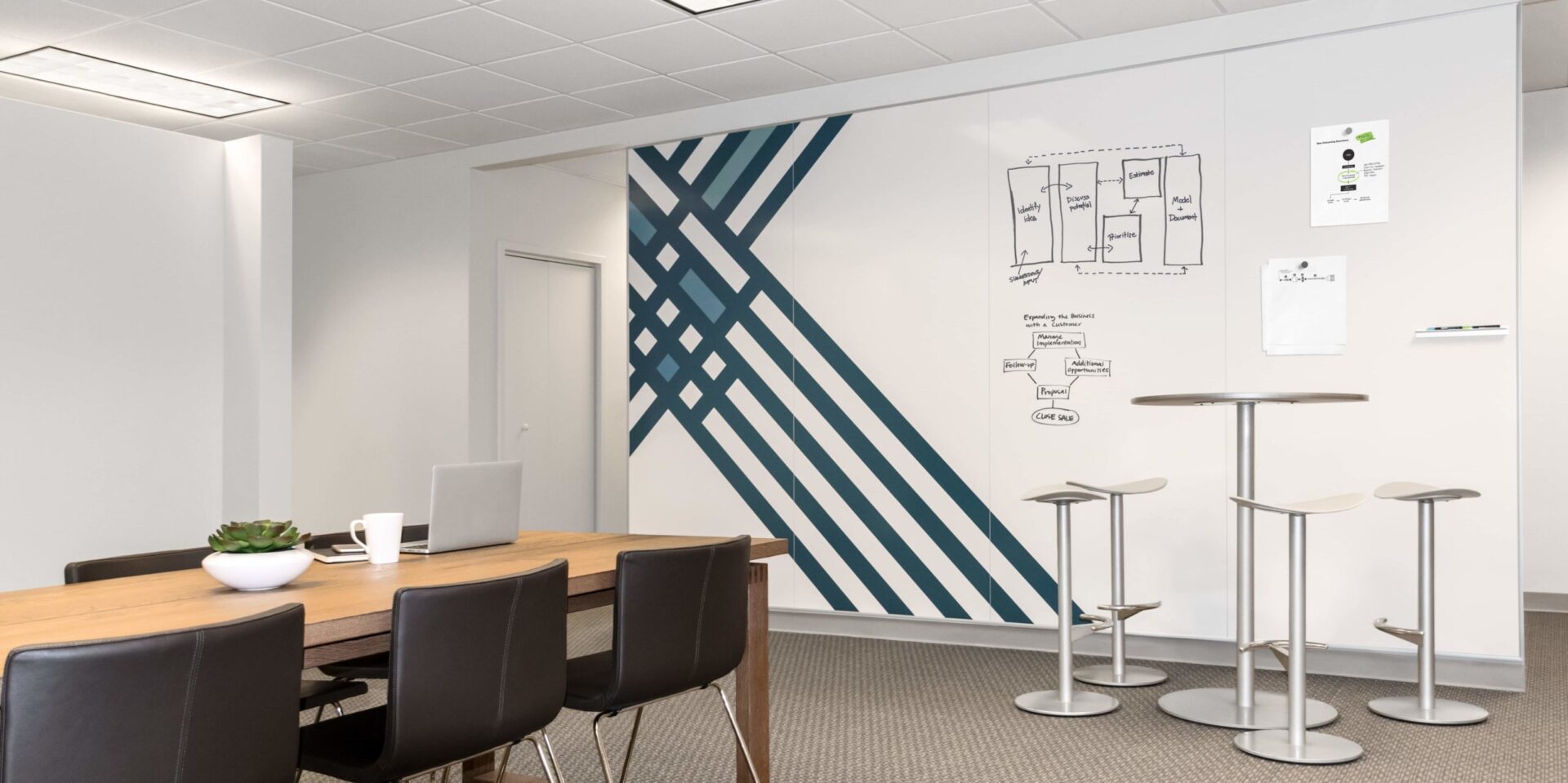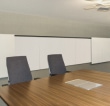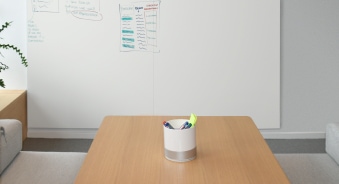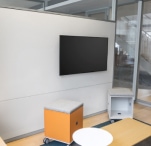CeramicSteel vs Whiteboard Paint
CeramicSteel vs Whiteboard Paint
Enter a quick web search and you will find an overwhelming selection of writing surfaces for use in offices, classrooms and homes. For a decision that requires a significant investment, it’s important to understand the benefits and drawbacks of each surface type. In recent years, the use of whiteboard paint, also called dry erase paint, has been a popular choice in the DIY community to make smooth, flat surfaces writeable. This appeal stems from the product’s relatively-low cost and easy application – who doesn’t want to write on their walls, doors and tables? It has even been used in some offices and classrooms. But just how durable is it? We put the paint to the wall to see how it compares to the quality and durability of CeramicSteel.
What is the difference?
Whiteboard paint is a high-gloss paint typically containing an epoxy additive that dries to an erasable surface. CeramicSteel, on the other hand, is a vitreous (aka glass-derived) enamel fused to steel to create a surface that is smooth, magnetic and resistant to stains, scratches, bacteria and fire.
Gloss
Superior writability begins with a smooth surface. CeramicSteel offers a glass-like writing plane from end-to-end. Conversely, when whiteboard paint is applied to a smooth, flat surface (often plastic or drywall) it reveals an “orange peel,” or bumpy, texture despite its application with a smooth paint roller. This produces a lower gloss than its CeramicSteel counterpart and creates friction, resulting in resistance when writing and erasing.
Erasability
As a non-porous surface made of inorganic material, CeramicSteel will not absorb ink, no matter if it is from dry erase or permanent marker. This means CeramicSteel writing surfaces will not “ghost” or stain. Dry erase marker ink can be wiped easily from the surface with a dry cloth or standard eraser, while pen ink, semi-permanent and permanent marker can be removed with a solvent-based cleaner.
The erasability of dry erase markers on whiteboard paint is lower than CeramicSteel because of its lower gloss level and uneven surface – not to mention, paint is porous. This becomes three times worse upon aging. All of this means that whiteboard paints will absorb ink from markers, staining over time, and they are not compatible with the use of permanent markers like CeramicSteel.
Surface Hardness
The definition of surface hardness is how strong or resistant to wear a surface is. CeramicSteel is a porcelain enamel and is as hard as glass. It will not dent and is not easily broken. In fact, it’s so strong Polyvision backs it with a Forever Warranty, guaranteeing the surface for the life of the building it is installed in or for the life of the product, whichever comes first.
Whiteboard paint is only as hard as the surface it is painted on. Damage and stains will happen more easily on a painted surface, just like any painted wall, and will not offer the same professional look as an unblemished CeramicSteel surface.
Scratch and Abrasion Resistance
International standards were used to test both whiteboard paint and CeramicSteel. The scratch resistance test clamps a sample of the surface to a turn table. A weight-loaded arm then drags a standardized diamond needle over the surface as the sample turns one revolution. The weight of the scratches is varied to make 10 different scratches. The scratches are marked with 4 different dry erase colors, dried and wiped clean before being evaluated. The scratches that permanently damaged the surface are shown if the dry erase ink stayed in on the scratched area after cleaning. In this test, whiteboard paint was easily scratched, and while the only thing that can scratch CeramicSteel is diamond, there was minimal damage to the surface.
Durability
Tests are performed on surfaces to determine their durability, mimicking long-term wear in high-intensity tests. The Taber abrasion uses a turntable and sand paper to measure wear resistance and durability.
CeramicSteel shows very little abrasion, while dry erase paint is eroded to the substrate. This shows that whiteboard paint will not maintain its quality in areas with heavy traffic and will not withstand long-term use. Over time, the surface will degrade and require re-painting or replacement. CeramicSteel will never decrease in erasability and the surface will not wear away over time.
Chemical Resistance
The purpose of testing for chemical resistance is to determine whether a surface will withstand frequent cleaning, chemical accidents in laboratories and other harsh settings. CeramicSteel is a non-porous, glass-like surface made of inorganic material. This results in a resistance to anything that attempts to permeate the surface, whether it is bacteria or harsh chemicals. Whiteboard paint does not hold up to chemicals, showing significant wear and reduced functionality after chemical resistance testing. This is a testament to the longevity of CeramicSteel when compared to whiteboard paint.
Magnetic Capability
Useful for posting bulletins, announcements and other important documents, a surface with functional magnetic capabilities is sought after in the market. The magnetic nature of CeramicSteel is evident in the name. As a vitreous enamel fused to steel, CeramicSteel is a surface with high-powered magnetism. Painted whiteboard surfaces are not inherently magnetic, so the paint must be applied to a magnetic surface to function as such. While offering magnetic capabilities is not at the center of a quality writing surface, it does enhance the value and functionality of the product.
Installation
The process for installing CeramicSteel whiteboards is as straightforward as hanging a picture. Arrange the mounting brackets where you would like the board to go, mark the holes and drill, hang the brackets and mount the board. This is a two-person process due to the weight of CeramicSteel whiteboards, but a simple one. Whiteboard paint requires wall preparation including painting, sanding and cleaning. Once this is complete, the two-part paint requires mixing. The paint itself often has a strong odor and proper ventilation is recommended. After the paint has been mixed, it should be rolled onto the prepared surface with a lint-free roller. Two or more coats are usually required for enough coverage. When the right look is achieved, a minimum of 24 hours is required for the paint to cure before use.
Closing
CeramicSteel and whiteboard paint both have their place in the world of writing surfaces. DIYers and craft aficionados enjoy the versatility and creative freedom offered by whiteboard paint products. For a professional, lasting investment that is sustainable, resistant to high-traffic environments and time-tested by students in more than 25 million classrooms around the world, CeramicSteel is the clear choice for education, corporate and healthcare environments.
Project Pictures
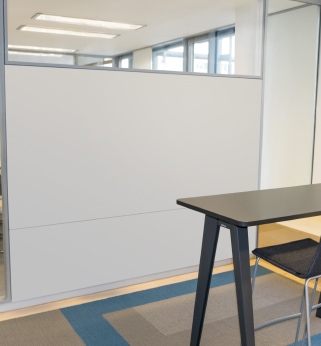
Let's Talk
We would love to hear from you! Contact us for sales requests, career information, corporate information, or general questions.
